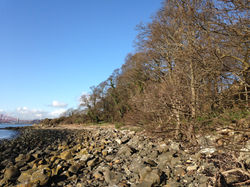Thistle Management
Anyone walking the Coastal Path down from The Triangle last Sunday (7th April) would have seen a line of volunteers digging up some plants growing at the very edge of the path. The plants being removed were thistles, mostly Welted Thistle, along with some Common (stinging) Nettles. These were all plants that by the summer would have grown quite tall and would have made a walk along the path a lot less comfortable than at present.


It is not that thistles do not have wildlife value, the flowers of some species can be a valuable food source for bumblebees, butterflies and other pollinating insects. Of the different thistles that we have, Creeping Thistle is however the least useful. This is the one seen most often on roadsides and waste ground with its pale purple flowers. While other thistles spread by seed, Creeping Thistle spreads very effectively through underground runners that can be several feet deep, and they bud from this root system at frequent intervals. This makes them impossible to control by digging out. We have Creeping Thistle in all the wildflower areas, and especially the Heritage Viewpoint, but generally not in the woodlands.

This species is said by some to be a valuable nectar source for bumblebees, but evidence from flower/bumblebee interactions studied both at Loch Leven and here in Dalgety Bay in 2015 suggests otherwise. When alongside other thistles, the great majority of bumblebee visits were to flowers of Spear or Welted Thistle and not to Creeping Thistle. The ratio was around 20 to 1 overall with some bumblebee species selecting 50 to 1 against Creeping Thistle.
Not only is Creeping Thistle less valuable for bumblebees, it is one of the plants that, without control, can quickly take over areas that have been set aside and sown with wildflowers. This can be seen in the photo of the wildflower initiative alongside one of the paths in Warriston Park, Edinburgh where Creeping Thistle has completely taken over the back of the wildflower border.

Control can however be achieved by pulling out the thistles each year just before they come into flower. This is when the store of food in the root is at its minimum and they have not started to replenish it to provide for the next year’s growth. This method proved very effective on the triangular area where the paths diverge as you enter Bathing House Wood from the west, but it will need to be repeated to make sure the thistles do not regain their earlier vigour.
The other thistles we have, Welted Thistle, and Spear Thistle, spread only by seed, and where the soil is disturbed, the seeds that have lain in the soil germinate, which is why we have them growing along the sides of the new path. At present they are just a rosette of leaves close to the ground with fairly shallow roots so they are easy to identify and remove. It was only the plants of this thistle close to the path that were being removed last Sunday. There are plenty of Welted Thistle plants further back that will develop and flower in the late spring and summer in time for any passing butterfly and the main rush of worker bumblebees in July and August.









































